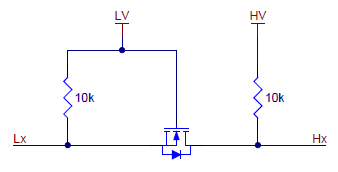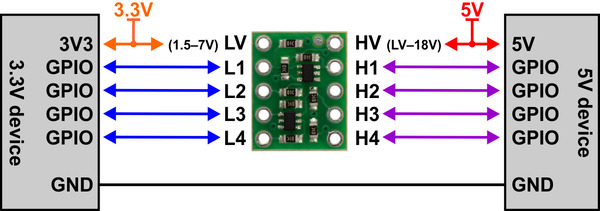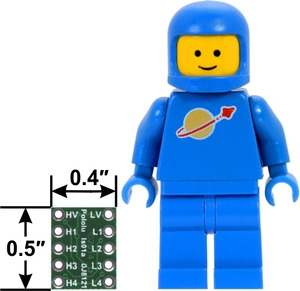Level shifting is a common issue when interfacing multiple microcontrollers or other digital logic devices. For example, you cannot directly connect an Arduino running at 5Â V to the Wixel, which runs at 3.3Â V. Our Wixel Shield for Arduino contains several level-shifting circuits to help you do this.
In some cases, such as connecting a digital sensor output to your microcontroller, a simple voltage divider or transistor inverter might be good enough. However, in many cases a better solution is necessary. I²C, for example, is a common protocol that makes use of a bidirectional communication line. Luckily, a relatively simple circuit consisting of a MOSFET and two pull-up resistors can be used for general-purpose bidirectional level shifting:
 |
Schematic of a single bidirectional logical level shifter. |
|---|
We have used this level shifter circuit on many of our breakout boards operating at a lower voltage, such as the MinIMU-9. It works like this:
- When Lx, the lower-voltage input, is driven low, the MOSFET turns on and the zero passes through to Hx.
- When Hx, the higher-voltage input, is driven low, Lx is also driven low through the MOSFET’s body diode, at which point the MOSFET turns on.
- In all other cases, both Lx and Hx are pulled high to their respective logic supply voltages.
The circuit works for any pair of voltages (within the limitations of the MOSFET) and can be used with most common bidirectional and unidirectional digital interfaces, including I²C, SPI, and asynchronous TTL serial. You can read more about it in NXP’s application note on I²C bus level-shifting techniques (54k pdf).
Today we released a logic level shifter board featuring four of these bidirectional channels:
 |
Our board can convert signals as low as 1.5Â V to as high as 18Â V and vice versa, so you can use it for almost any logic-level signals that you might encounter in your project. It is also, as far as we know, the smallest bidirectional logic level conversion board out there:
 |
Note the use of a more internationally-appropriate size reference than our traditional U.S. quarter. After we put together this image, nobody believed that the board was actually that small, but we verified it several different ways to make sure.
Anyway, with this board’s small size, low cost, and versatility, we think it is something that everyone should have in their toolbox. For more information or to order, see the product page.
Nervos is an ambitious newcomer on the crypto market and Changelly has long watched it with interest. The project attracted the attention of investors and developers since its purpose is not to launch another cryptocurrency in the ecosystem. Nervos is a simple connecting database between any blockchains.
Nervos was launched in November 2019 by Nervos Network and aims to fix issues that plague both Bitcoin and Ethereum. Among them are scalability and value differences. To fix them, the Nervos team wants to implement effective scalability and raise the cost of their token by hosting other cryptocurrencies on their blockchain. Nervos supports smart contracts and is censorship-resistant. CKB is a native token of the Nervos network. It scales with the value of other assets stored on the network: the more cryptos and tokens are there, the more valuable CKB becomes. This means that this token will continue raising its value the more attention and assets it attracts. Add to that the support of smart contracts, and you have a nice crypto bridge between different blockchains. Which is exactly what makes it so attractive for both crypto enthusiasts and investors.
ckb mining machine,eaglesong algorythm,ckb miner,goldshel ck6,goldshell ck5
Shenzhen YLHM Technology Co., Ltd. , https://www.apgelectrical.com


